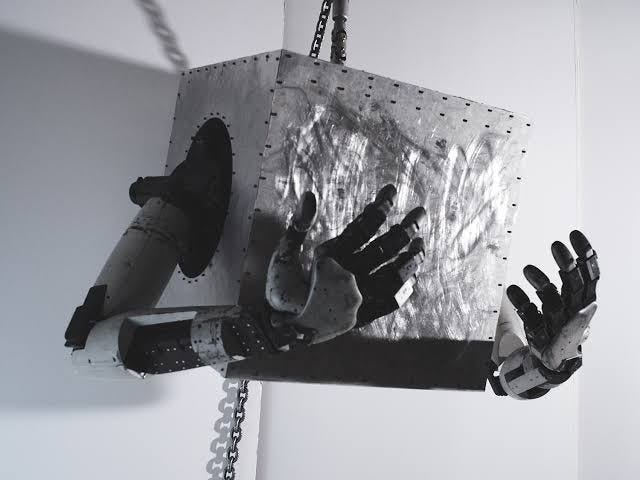Give Up Or Give In: On Jordan Wolfson's Body Sculpture
The development of the object-in-general, and frustration.
Jordan Wolfson’s Body Sculpture (2023) is his most abstract sculpture to date. It has no eyes and is meant to have no eyes. The staring tendency in his earlier work, Wolfson has said, had become a pattern and had to be broken, to show that anything passes.1
Staring in the eyes in Wolfson’s early work ‘created a kind of formal bridge, it was kind of like this bridge and any content could pass over this bridge, and everything became equalized, and the greater differences in texture the more equalizing it was’. This ‘very interesting effect’ of an unbroken stare becomes a feature of all his work thereafter, including Female Figure (2014) and Colored Sculpture (2016).
The formal bridge which equalizes all content (or art) gets repeated across a series of works until the artist reaches a moment of having to stop. The moment of ‘any content’ is gone beyond. He says, ‘I kind of felt like I had to let go of it’, and: ‘the reality is you can’t do the same thing over and over once you’ve got good at it’. He adds, ‘life is about change and change is inevitable’.
The eyes that enable the stare to be the formal bridge for a while are therefore removed and Body Sculpture is that moment. Body Sculpture is not about that moment; it is that moment. It’s the moment the formal bridge of ‘any content’ being equalized is left behind, but it’s also the moment the eyes and face are removed, and so paradoxically it’s as if Wolfson becomes less formal in this moment. ‘Once you’ve done it enough times, you’ve done it enough times, you don’t really have beginner’s mind anymore.’
The development of Wolfson’s art is therefore both anatomically reductive and aerobic (he describes himself as an athlete); it is an art that counts formal accomplishment as a type of growing up (giving up or in). This is what leads to the ‘active decision’ for Body Sculpture not to have eyes.
It is a commonplace in contemporary disaster studies and in various types of trauma theory to claim that the end of the world has already happened to the less enfranchised of the earth, that if you want to know what the end of the world looks like ask those to whom it has already happened. But this assumes and prejudges what the end of the world will have been, as if in any kind of end we can imagine the end of the world were only ever a further endlessness, a repeat. In Wolfson’s description of his own art it is as if he is describing the getting over something that can’t be gotten over. The formal bridge is a formal bridge for any content to pass over and so there really isn’t any other bridge at all, only a choice as to what content you wish to pass over it. Female Figure had a face and now Body Sculpture does not, but we are still within the domain of ‘any content’. Whether this passing of the object (even the end of the world) be compared to survivor guilt or to what the Lebanese artist Jalal Toufic ambiguously calls ‘surpassing disaster’, going beyond the formal bridge that carries all content towards a sculpture that is Wolfson at his most abstract must also be taken as non-additive in a sense that might be explored.
One begins to wonder if there is something properly frustrating about this moment in Wolfson’s work, frustrating as it does the previous impulse to engage the viewer in a staring competition. But frustration in this case might be heard differently, as Lacan said in Seminaire VIII,
Versagung [frustration] implies a default to the promise, and a default to a promise for which everything has already been given up, and this is the exemplary value of the personnage and drama of Sygne.
The reference is to Paul Claudel’s La Trilogie des Coûfontaine. Frustration is not just frustration, sexual or otherwise; it’s the giving up of something for which everything has already been absolutely given up. It’s the giving up or in after the giving up or in has already been done. It’s the sculpted space or face left over after a face has been removed.
The object in general—which is sometimes the end of the world as an end to endlessness leaving signs in the flesh—once encountered as a kind of formal bridge—cannot really be gone back on. We can’t turn round and go back across this particular bridge, and yet the object broadly—no matter how final—is nonetheless something that we get tired of repeating our attachments to. Perhaps Body Sculpture has no eyes because there is nothing else but this to see, and this is the feeling, the body, the feeling of the body, and the body of the feeling.
The bridge is still there, and so are the eyes, for now. In the end, you can’t catch up with that thing. Even love won’t go that fast. You can’t grow up for it or grow up to it, so to speak. In either case, there is no sculptural relief.
Nearly all the quotes in this text are taken from the recording of Wolfson’s interview with Johanna Burton, dated 25 February 2024.


